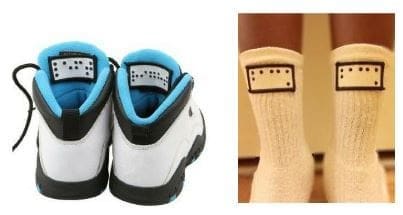Dr Babita Bhandari
Assistant Professor, National Institute of Fashion Technology, Kangra
*corresponding author: babita.bhandari@nift.ac.in
ABSTRACT
Clothing is a basic necessity of every human being. It serves to satisfy the physical, emotional, psychological and social needs of the individual. The various elements of clothing design like colour, textures, silhouettes, functional features, decorative features are assessed and analysed to make suitable clothing choices. Designing inclusive clothing for the visually impaired people can help them buy and use clothing conveniently. In this paper, the efforts carried out by designers and researchers have been documented.
Keywords: Clothing design, visual impairment, inclusivity
INTRODUCTION
Globally, at least 2.2 billion people have a near or distance vision impairment. In at least 1 billion or almost half of these cases, vision impairment could have been prevented or has yet to be addressed. Children affected by vision impairment can experience delayed motor, language, emotional, social and cognitive development with lower levels of educational achievement. For adults, it may cause depression, lower productivity at the workplace, social isolation, difficulty in walking, and often have a risk of falls and fractures.
People use various senses to buy and wear appropriate clothing and accessories in terms of colours, patterns, textures, sizes, pricing that reflects one’s fashion sense and social status.
However, when the individual is having any kind of disability to identify any of these elements, this may prove to be a major hurdle for the affected person in selecting and wearing clothing in appropriate manner. For these seemingly simple steps, one has to rely on family members to help them in buying and wearing clothing.
As per the data, vision impairment affects people of various age groups in varied manners.
Clothing design for such people with special needs can go a long way in ensuring a better quality of life and reducing the extent of some of the major problems faced by the people with affected vision. Some researchers have also worked in designing clothing tags using braille technology which includes complete clothing details and a guide to wearing clothes.
Research conducted by Alali, R. M. from Midwest university also states that visually impaired individuals face challenges while shopping for clothing, especially in the identification of the prices, color, and size of the clothes. The results show that dependence on family members is high and seems to be a primary option the participants have. Additionally, a majority of the participants indicated that a Braille label for clothing is important to enable them to shop for the clothes of their choice. Participants confirmed that they would desire attributes, especially color, price, and care, to be included on Braille labels.
There are certain brands which are trying to cater to the needs of visually impaired people by putting small interventions in clothing design. Hence in this paper, an attempt has been made to document the efforts taken by various brands and individual designers to design inclusive clothing for the visually impaired people.
DESIGN INTERVENTION BY BRANDS
- Braille tag: Braille is the tactile writing system used by people who are visually impaired, including people who are blind, deafblind or who have low vision. It can be read either on embossed paper or by using refreshable braille displays that connect to computers and smartphone devices.
Some designers have used this concept by incorporating braille in clothing design and in clothing tags.

Braille Code Brands, Inc. from New York, applies braille patches to the outside of socks or inside of a pair of shoes to enable the visually impaired people easily and independently identify for easing up the process of wearing shoes and socks correctly. These raised braille patches can be easily sewn on or ironed onto socks, shoes and shirts especially designed for affected kids.
Two Blind Brothers brand includes information in Braille on the tag and creates casual shirts for men and women that are accessible to people with vision impairment. The most interesting thing is that 70 percent of their employees are also blind, and everything they earn is used to finance medical research and clinical trials aimed at curing blindness.
Sonar brand by Argentinian designer, designs urban clothing with attractive design features for both sighted and non-sighted people. The brand uses relief, embroidery, textures along with braille to provide information about clothing including wash and care instructions.
- Surface techniques: Embroideries made with beads, palettes and tacks can be used to spell out the information on the surface of the dress making it look visually appealing while also giving important information to the wearer.
- Printing using puff paint: Two Blind Brothers print letters in braille technique using puff paint. The apparel products have braille tags and name of colour embroidered in braille above the bottom right hemline, which allows those with a visual impairment to read the color of the shirt. These subtle, yet impactful details are symbolic, functional and stylish. As the visually impaired people have strong tactile sense, so these garments are made of Ultra-Soft Tri-blend Jerseys having blend of 50% Polyester, 25% Cotton, 25% Rayon. They also use a premium bamboo blend for softness, comfort and durability in 66% Bamboo, 28% Cotton, 6% Spandex.
Conclusion: Hence it can be concluded that designing clothing for the visually impaired can go a long way in making these people self-reliant in their day-to-day activities and reducing their dependency on other people. Also incorporating inclusive intervention into their clothing which makes the affected people an integral part of mainstream society can ensure their emotional and social wellbeing.
REFERENCES
- https://www.who.int/news-room/fact-sheets/detail/blindness-and-visual-impairment
- https://respectcaregivers.org/adaptive-clothing-for-blind/
- http://idealogyjournal.com/ojs/index.php/idealogy/article/view/227
- https://www.cdc.gov/visionhealth/basics/ced/fastfacts.htm
- https://twoblindbrothers.com/
- Karim, K. A. A. 2020. The Challenges Faced by Visual Impairments in Buying Clothes and How to Wear Clothes, Idealogy Journal, Vol 5 No 2 DOI: https://doi.org/10.24191/idealogy.v5i2.227
- Bello, A. 2017. New clothing line offers the blind fashion they can “see” retrieved from https://aleteia.org/2017/10/26/new-clothing-line-offers-the-blind-fashion-they-can-see/
- A case study of visually impaired individuals’ preferences of the availability of Braille clothing labels in shopping and selection of apparel retrieved from https://cardinalscholar.bsu.edu/handle/123456789/200841
- https://www.perkins.org/resource/clothing-choices-blind-and-visually-impaired/

